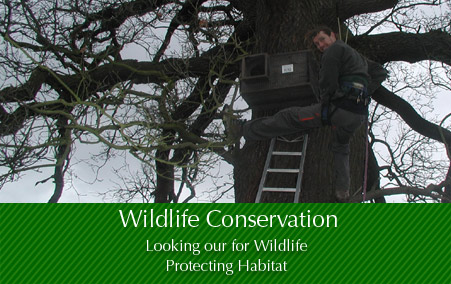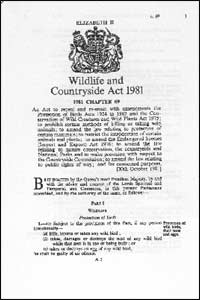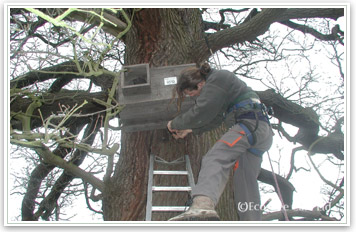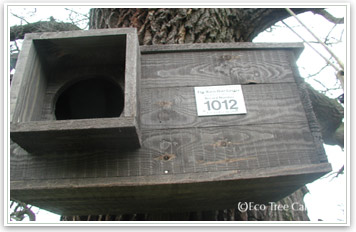Wildlife Conservation
Bats, Nesting Birds, Countryside and Wildlife Act

Looking out for Wild birds - The Nesting Season
Wild birds are protected by law. For the woodland manager and arborist this
becomes particularly pertinent during the spring nesting season where tree
work activities can have obvious devastating effect on the nesting sites of
wild birds.
The Wildlife & Countryside Act 1981 is one of the most important pieces of Wildlife legislation in this country.

It states it is an offence to...
![]() Intentionally kill, injure or take any wild bird
Intentionally kill, injure or take any wild bird
![]() Intentionally take, damage or destroy the nest of any wild bird while that
nest is in use or being built
Intentionally take, damage or destroy the nest of any wild bird while that
nest is in use or being built
![]() Intentionally take or destroy an egg of any wild bird
Intentionally take or destroy an egg of any wild bird
The Wildlife & Countryside Act 1981 has several subsequent amendments the most important being the The Countryside and Rights of Way Act 2000 (CROW) which under Schedule 12 of the Act strengthens the legal protection for threatened species. It also makes certain offences 'arrestable' and importantly and significantly creates a new offence of reckless disturbance. It also confers greater powers to police and wildlife inspectors for entering premises and obtaining wildlife tissue samples for DNA analysis, and also enables heavier penalties on conviction of wildlife offences.
Schedule 12 amendment state
1. In section 1(5) of the 1981 Act (offence of intentional disturbance of wild birds) after "intentionally" there is inserted "or recklessly".
The implications for tree surgeons and tree surgery works is further increased with this CROW amendment. It is no longer a defence to say that you were not aware that there was a nest present if it can be shown that you have acted "recklessly" and without due care and attention. It is important to inspect the trees & hedges thoroughly before commencement of work and also look thoroughly in the immediate proximity of the works, this should be noted down as part of the Risk Assessment done before the start of every job. If nesting birds are found to be present then the tree work must not commence, or if the tree surgery has already started and nesting birds are then discovered then the work must stop immediately and be rescheduled for later in the year.
The nesting season is generally considered to be from early march to late August*. Even then there will still be many birds tending to chicks in nests well in to September. Note though that birds can and do nest earlier and later than this. They don't do dates! Hedge pruning and clearing of dense vegetation in a woodland should be restricted during these times as it is nigh on impossible to ensure that there are no nesting birds.
* (This period has been stated by a member of the RSPB Investigations Team and a Wildlife Crime Officer).
If tree works are being done in late July & August then there should still be extra vigilence employed.
It is our responsibility as professional arborists to inform clients of this restriction to our activities and educate them about the legal protection that is afforded to wild birds.
The implications for the House owner / client is that they should become aware that tree surgery work may not be able to carried out during the nesting season and that they have a environmental and legal duty not to employ unscrupulous 'tree surgeons' to carry out works during the nesting period.
If you are a neighbour to some tree works being carried out where you know there nesting wild birds then make this known to the house owner or tree surgeons. Their actions then become intentional if they proceed. You can contact the RSPB on 01767 680 551 or visit their website form for reporting 'wildlife crime'
Certain species, in some circumstances, are considered as pests and so are not on the Schedule 1 of the Wildlife and Countryside Act 1981 (those listed below) and therefore the offence of reckless or intentional disturbance does not apply.
However, the offences of intentionally taking, damaging or destroying the nest or intentionally taking or destroying the eggs of any of these birds does apply - as do the offences of intentionally killing, injuring or taking any of these birds (this includes chicks). These offences all appear under s.1(1) of the WCA 1981.
It is also an offence to 'attempt' to commit any of these offences (s.18(1)).
This applies to the following species
![]() Carrion Crow
Carrion Crow
![]() Lesser black-backed gull
Lesser black-backed gull
![]() Jay
Jay
![]() Rook
Rook
![]() Woodpigeon
Woodpigeon
![]() Collared Dove
Collared Dove
![]() Herring gull
Herring gull
![]() Magpie
Magpie
![]() Great black-backed gull
Great black-backed gull
![]() Jackdaw
Jackdaw
![]() Feral Pigeon
Feral Pigeon
![]() Starling
Starling
Some species can be controlled in certain circumstances - this is set out in general licenses issued by Natural England.
However all the conditions of the license being used must be complied with in order for the activity to be legal.
These licenses can be found at www.naturalengland.org.uk/conservation/wildlife-management-licensing/genlicences.htm
(Starlings only appears on the general license concerning work carried out
to preserve air safety by managers of aerodromes and persons authorised by
them.)
Further resources
View the Wildlife and Countryside Act 1981 on the Joint Nature Conservation Committee website
The Countryside and Rights of Way Act 2000 (CROW)
Defra (Department for Environment, Food and Rural Affairs) Website
Don't fall fowl of the Wildlife Law by Andrew Cowan (ArborEcology)
Details of Species under general licence with DEFRA
Encouraging habitat and biodiversity
The value of deadwood
When considering the management of trees in gardens
there should also be a consideration of wildlife conservation. For
example sometimes
Further resources
World Wildlife Fund - "Deadwood - Living Forests"
Trees for Life: Restoring the Caledonian Forest
Nesting boxes
The continual urbanisation of our countryside and the trend towards tidying
up trees and woodland for safety & asthetic reasons means that the number
of available nesting sites has and is continuing to diminish. Recent legislation
and grants available to land owners has started to address this problem.
Putting up nesting boxes is a rewarding and valuable asset to our local environment and is something that can be done easily by anyone with a tree.
  |
As part of our Wildlife Conservation work we have been asked to site nesting boxes ranging from those for small birds like blue tits all the way up to boxes for Barn Owls.
It is possible to purchase very good quality barn owl boxes online from the Barn Owl Centre of Glouctershire, at a very reasonable price. Goto the online shop. You will find bird boxes for the smaller wild birds also. The boxes come with all the fittings and instructions of how to put up.
Alternatively make your own.See the RSPB Nest Box Page for instructions and specifications for different birds
Make sure you have a few pairs of hands to do it safely, or contact your tree surgeon to site them in the trees.
Bats
Bats also live in trees, they use
them to roost, give birth, raise young, form groups and hibernate. They are
nocturnal and feed on insects associated with trees.
An even greater awareness than that for birds is necessary when working on
trees at any time of year due to the inherent difficulties involved in spotting
bat habitats.
Bats live in holes, cracks, crevices, splits & cavities. They can also
roost under flaps of bark or amongst roots or under dense ivy cover. Favourable
conditions for bats therefore occur particularly in mature trees, the most
utilised tree species being oak, ash, beech and scots pine.
Signs of bat roosts in trees
What to look for:
• obvious holes, cavities and splits
• dark staining on the tree below a hole .staining around a hole caused
by the natural oils in bats' fur
• a maze of tiny scratch marks around the hole from the bats' claws
• droppings below a hole -they look similar to those of rodents, but
crumble to a powder of insect fragments
• noise (squeaking or chittering) coming from a hole - especially on
a hot day or at dusk
• on close inspection a hole may contain droppings or smell of bats
Apart from looking for these signs, ask if there is any history of bats, check
holes by inserting a mirror, and watch for bats emerging at dusk or returning
at dawn
The company does have a bat detector unit and if a particular tree is highly
suspected to be a roost for bats this equipment can be used to help confirm
if this is the case. The bat survey will be necessary during dawn or dusk.
If in doubt contact the Bat Conservation Trust and seek further advice from
a licensed bat worker
If a roost is found then stop all
work
• If the roost is still on the tree and bats
are not injured, seek advice. If help is not available, allow bats to fly
out of harm's way
• If the timber is felled, the roost is not exposed and the bats are
not injured, temporarily seal and isolate roost and seek help. If help is
not readily available, position the roost off the ground, re-open it and allow
bats to relocate of their own accord
• If roost has been exposed, and especially if bats have been injured,
collect bats into a secure box or bag (using a glove) and seek advice
If evidence of bats is discovered, even if no roost is found or bats seen,
then all work must cease immediately and any cut branches or sections of tree
already removed should be left overnight where they are to allow any bats
a chance to relocate.
In all cases notify the Bat Conservation Trust and the local bat group of
your find.
Best working practice
• Bats may be anywhere inside a hole. Exact advice
cannot be given, but try to cut as far above any likely hole as possible
• If in doubt whether it is a roost, do not cut, seek advice
• Bats may be inside cracks held open by the weight of a branch, which
will close when weight is taken off. Search such splits for bats before removing
large limbs and consider wedging open
• When felling ivy-clad trees, once felled allow a 24 hr rest period
before snedding and removing ivy
Bats - The Conservation of mature trees & woodland habitat
Management practices have tended to result in mature
trees and dead wood being 'tidied up' However, there is increasing recognition
of the conservation value of standing dead and dying trees.
Where a mature tree or part of a tree presents a real danger to people or
property, there may be no alternative to pruning or felling.
Often trees can be made safe by pruning rather
than felling, thereby retaining their value to the environment.
Where conditions permit, it may be possible to retain some trees supported
by guys. Branches can be supported by slings or props.
Bats and the law
All bats are protected under the Wildlife and Countryside
Act (Schedule 5). They are also included in Schedule 2 of the Conservation
Regulations 1994.
The Act and Regulations include provisions making it illegal to:
• intentionally or deliberately kill, injure or capture (take) bats
• deliberately disturb bats (whether in a roost or not)
• damage, destroy or obstruct access to bat roosts
A bat roost is interpreted as 'any structure or place which is used for shelter
or protection', whether or not bats are present at the time. If proposed work
is likely to destroy or disturb bats or their roosts the appropriate Statutory
Nature Conservation Organisation (SNCO) must be notified and allowed a reasonable
time to advise on whether the proposed work should be carried out and, if
so, the method to be used. The earlier advice is sought, the better.
European Protected Species
Recent legislation came into force on 21st August 2007 which has strengthened legislation for some protected species. The relevant species to trees and woodlands are
- all 17 species of bat
- dormouse
- great crested newt
- otter
- sand lizard
- smooth snake
Since 1994 it has been an offence, under these Regulations, to deliberately kill or cause significant disturbance to a protected species, or to deliberately destroy their eggs. It has also been an offence to ‘damage or destroy a breeding site or resting place’ used by them (such as a bat roost in a tree or a dormouse nest on the woodland floor).
The amended regulation will include as an offence any damage or destruction of a breeding site or resting place. Previously if damage was ‘an incidental result of a lawful operation' and reasonable precautions had been taken to avoid it, it would not have been an offence. Therefore there is a risk of woodland operators committing an offence if they have not carried out planned operations carefully, with the necessary checks and sought a license where required.
Woodland managers will need to consider the presence of protected species and follow good practice guidance to avoid committing an offence. In some cases management practices may need to be modified or rescheduled to a less sensitive time of year, and where this is not possible or adequate then operators may need to apply for a licence to remain within the law. Most activities will be able to continue without the need for a licence through the following of good practice guidance.
The Forestry Commission - nationally through
this resource and locally through our network of regional offices - will be
able to provide support in relation to the changes and the guidance provided
where protected species are present, and will process any applications for
licences to carry out work where they are needed. The licences will be issued
by Natural England's National Licensing Unit.
More info can be found at
http://www.forestry.gov.uk/england-protectedspecies
and
http://www.naturalengland.org.uk/conservation/wildlife-management-licensing/habsregs.htm

